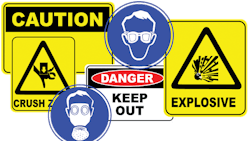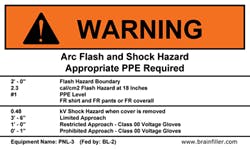Write It and Light It: Signs, Labels and Lighting for a Safe and Productive Workplace
For industrial or manufacturing workers, labels and signs reduce wasted time spent searching for inventory, prevent accidental handling of toxic chemicals and guide us to the nearest exits in the event of a fire.
But like workers, labels and signs can't do their job in poor lighting. Industrial buildings need well-planned lighting systems for different tasks with appropriate light quantity and quality to keep workers safe and productive.
"Adequate lighting in the work environment improves safety, accuracy, alertness and a feeling of well-being," says lighting designer Tom Dearborn of Dearborn Lighting Design.
In one facility, color-coded shadowboards, magnetic production schedule boards and operating instructions were prominently placed. With signs and labels identifying, coding and directing just about every department including plating, molding, assembling and shipping, the adherence to Kaizen/5S/lean manufacturing was outstanding – but with poor fixtures and few windows, workers strained under inadequate lighting.
"Using day-lighting in the work environment, where appropriate, provides a link to the outdoor environment. But the architecture of the space must lend itself to such use," says Dearborn.
Safety at Eye Level
Labels and signs must communicate a message, connect the employee with a particular item like a machine and must be consistent so everyone in the facility gets the message.
Effective visual communication relies on several conditions including age and font size. A 40-year-old employee, for example, generally requires twice as much light to perform a task as a 20-year-old. Small font text that moves rapidly past a reader and out of sight needs a significant amount of light for comprehension. Large, stationary objects are easier to see in lower light levels.
"Signage should be installed at eye level in the person's path of direction. The lighting level will be best noticed if it is illuminated 10-15 times the ambient light level of the space. The higher the contrast ratio between signage and the background, the better. Our eyes are drawn to light, so if the signage is important, focus a beam of light onto the message. Example: If the ambient light level of an office, laboratory or corridor is measured at 20 foot-candles [2 lux], the signage [instant recognition] should be at a minimum of 200 foot-candles [20 lux]," says Dearborn.
When it comes to conveying an important message, simplicity often works best. "The three most common messages we use at our water treatment plant are: Danger, No Entry and Oxidizer," says Kevin Freber, assistant water systems manager for the city of Watertown, Wis.
Stick with the Right Label
Selecting the right label material is essential. Labels need to withstand temperature extremes, solvents, prolonged direct sunlight, vibration and changes in lighting.
"At low light levels, color contrast diminishes, so colors of similar reflectance such as a medium red and a medium blue will not be as conspicuous as opposite reflectances, such as light yellow and deep green. Using specular (mirror-like or polished) materials causes the material to be bright or dark depending on the direction of the light source. Use matte paints and finishes, with considerable color and reflectance contrast, so no matter what the type of lighting, messages are readable. Don't put a sign under glass unless the glass is in the vertical plane and not opposite a window," says lighting designer Jim Benya of Benya Lighting Design.
"Workplace lighting usually is fluorescent – efficient, predictable and cost effective," Benya adds. "There are two kinds of fluorescent lighting: direct light, in which the lamps shine down through lenses or louvers, and indirect light, in which lamps shine up and bounce off the ceiling. Each has its place. Some LED lighting systems are entering the marketplace now, and they are good, but not yet cost competitive."
Common industrial labeling applications include:Arc Flash – Arc flash is a type of electrical explosion that results from a low impedance connection to ground or another voltage phase in an electrical system. The most common causes of arc flash are dropped tools, debris or corrosion in electrical equipment and human error. The potential for and level of arc flash hazard is determined by arc flash studies. Labeling provides workers with the information necessary for protection.
Pipe Markers – ANSI and ASME code requires pipes that convey, distribute, mix, discharge and control fluid flow to show their contents, potential hazard level and flow direction. Labeled pipes provide employees and emergency responders with information about piping system contents so they can make the correct decisions about repairs and maintenance.
Wayfinding – Wayfinding signs and labels are found on exits, entrances, restrooms, fire escape routes, buildings, hallways and stairwells. Graphic standards should include consistent typeface, size and space for margins and between words. All wayfinding signs must comply with the American Disabilities Act (ADA). Wayfinding signage may need to change frequently because of relocations, new hires, reorganizations and vandalism. Signage must be durable, cleanable and consistent with the look and feel of the building. Wayfinding signs related to safety, such as exit signs, need to conform to the NFPA 101 Safety Code. This code specifies the placement, size and lighting requirements for exit signs.
Additionally, glow-in-the-dark or phosphorescent labels and signs are designed for emergency situations to help guide people to safety. Highly reflective labels are easy to spot and read.
Sign and Label Inspection Guidelines
Labels should be maintained to ensure legibility and readability. Inspection frequency is determined based on the expected life of the label or sign, the environment and the severity of the hazards present. Are the label's edges curling? Floor-marking tape in particular takes a beating from foot and forklift traffic.
Consider relabeling before an inspection or audit. The most commonly used material for an industrial sign or label is vinyl, which works well in plants, warehouses and other industrial facilities that get high traffic and contact from machines and workers.
At the end of the day, balancing lighting, signs and labels is critical to creating the safest and most efficient industrial workplace.
Jack Rubinger of Portland, Ore., is an industrial copywriter for Graphic Products Inc. and DuraLabel.com. He has more than 20 years of experience writing for safety, industrial and trade media. Graphic Products manufactures industrial labeling systems used by multinational corporations including P&G, Amazon.com, Georgia-Pacific, Boeing, John Deere, Conoco, Sara Lee, Toyota and General Electric. For more information, visit http://www.DuraLabel.com.

